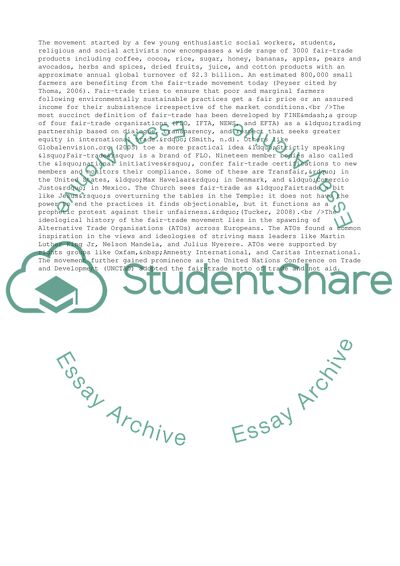Cite this document
(The Fair-Trade Movement Assignment Example | Topics and Well Written Essays - 1500 words, n.d.)
The Fair-Trade Movement Assignment Example | Topics and Well Written Essays - 1500 words. https://studentshare.org/business/1712702-1what-aims-and-purposes-motivate-the-fair-trade-movement-to-what-extent-do-you-think-that-the-methods-adopted-by-fair-trade-organisations-achieve-those-aims
The Fair-Trade Movement Assignment Example | Topics and Well Written Essays - 1500 words. https://studentshare.org/business/1712702-1what-aims-and-purposes-motivate-the-fair-trade-movement-to-what-extent-do-you-think-that-the-methods-adopted-by-fair-trade-organisations-achieve-those-aims
(The Fair-Trade Movement Assignment Example | Topics and Well Written Essays - 1500 Words)
The Fair-Trade Movement Assignment Example | Topics and Well Written Essays - 1500 Words. https://studentshare.org/business/1712702-1what-aims-and-purposes-motivate-the-fair-trade-movement-to-what-extent-do-you-think-that-the-methods-adopted-by-fair-trade-organisations-achieve-those-aims.
The Fair-Trade Movement Assignment Example | Topics and Well Written Essays - 1500 Words. https://studentshare.org/business/1712702-1what-aims-and-purposes-motivate-the-fair-trade-movement-to-what-extent-do-you-think-that-the-methods-adopted-by-fair-trade-organisations-achieve-those-aims.
“The Fair-Trade Movement Assignment Example | Topics and Well Written Essays - 1500 Words”. https://studentshare.org/business/1712702-1what-aims-and-purposes-motivate-the-fair-trade-movement-to-what-extent-do-you-think-that-the-methods-adopted-by-fair-trade-organisations-achieve-those-aims.


